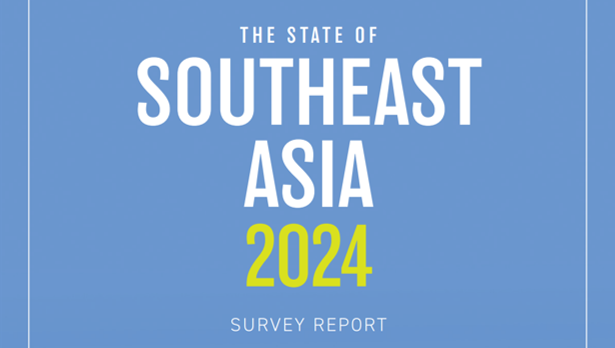Annual Study
ISEAS-Yusof Ishak Institute’s ASEAN Studies Centre published its annual “the State of Southeast Asia 2024 Survey Report” on April 2nd. The ASEAN Studies Centre began the survey in 2018 to “gauge the views and perceptions of Southeast Asians on geopolitical developments affecting the region and key international affairs.” The survey also gains data to gain insight into how ASEAN Dialogue Partners “have engaged with the region over the preceding year.”
The objective of the survey is to gain a “snapshot of the prevailing attitudes among those in a position to inform or influence policy on regional issues.” However, the centre also points out that the survey is “not meant to present a definitive view of issues in the region.” The 2024 survey was conducted over a span of approximately seven weeks, from January 3, 2024, to February 23, 2024. The survey was conducted in six languages: Bahasa Indonesia, Burmese, English, Khmer, Thai, and Vietnamese. The survey had 1,994 respondents who participated in the survey by responding to the questions.
The survey has six sections: the first two sections provide details on the respondent profiles by affiliation, age, education, and nationality, the region’s outlook, and provide “viewpoints on international affairs in the past year. Section Three examined the regional influence and the leadership of major and middle powers in the region, while Section Four explored “ASEAN’s options in the changing regional political-security architecture.” The fifth section “measures perceptions of trust among Southeast Asians towards five countries”—China, the European Union, India, Japan, and the United States.” The last section measures the soft power levels in the region based on travel and work relocation choices. The survey organizers reorganized the questions and results for “optimal flow and reporting,” and they also rounded the numbers down or up to the nearest one decimal point.
2024 Survey
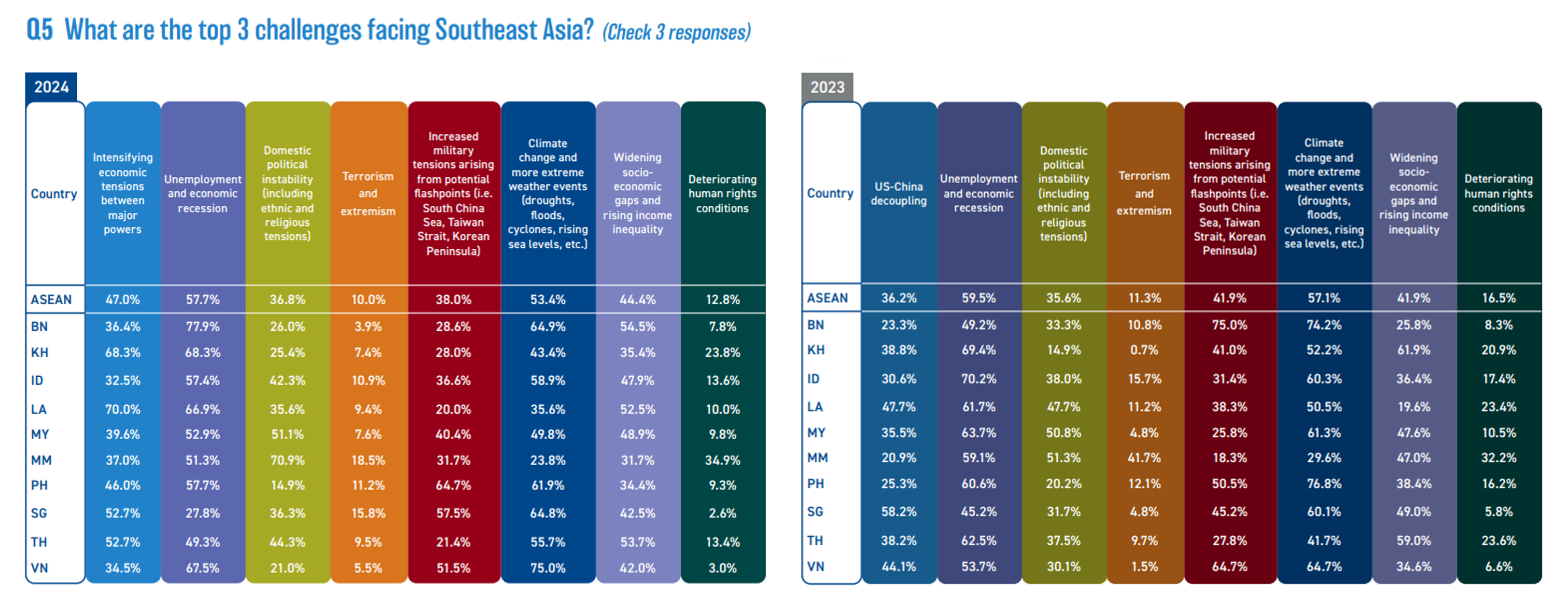
One of the key points of the survey is that the individuals still face “unprecedented challenges in the rapidly changing global geopolitical and economic environment.” Furthermore, these challenges also occur in the context of “evolving dynamics between major powers.” For example, unemployment and economic recession remain the most significant concerns for the Southeast Asia region at 57.7 percent. The ongoing Israel-Hamas conflict, the Houthi’s missile attacks in the Red Sea, and China’s economic slowdown likely drove the respondents’ concerns. However, respondents from Brunei, Cambodia, and Vietnam are “particularly concerned” with unemployment and economic recession. However, Singapore is “an outlier,” with 27.8 percent of respondents saying it is a fear.
Frequent and intense weather remains the second highest challenge for 53.4 percent of the region’s respondents. However, Vietnam has the highest number of respondents that voice their concerns about climate change impacts, at 75 percent, which overtook the Philippines. However, Singapore, Indonesia, and Thailand also have a high number of respondents who stated that climate change is the most significant concern. The three countries face significant difficulties due to the adverse weather patterns as well as rising sea levels.
The intensifying economic tensions between major powers are the third highest issue among respondents, at 47 percent. The survey rephrased the response from ‘U.S.-China decoupling’ found in the 2023 survey. Furthermore, it also increased to become the third ranked response instead of the fourth in last year’s survey. Respondents from Laos and Cambodia viewed the issue as especially substantial, with 70 percent of Laotians and 68.3 percent of Cambodians saying it was their most significant concern. Both countries have expanded their diplomatic and economic relationships with China substantially in recent years.
Taiwan Conflict
The survey also asked two questions about a potential Taiwan Strait conflict and how it would affect the region. The responses indicate that the respondents “recongise that any hostilities in the Taiwan Strait would have significant implications for the region” due to the region’s geographical proximity and economic ties with China and Taiwan. Overall, 44.2 percent of respondents in the region said that economic interests were their most significant concern. Specifically, they framed the economic interests as having the potential to “severely disrupt supply chains between China, Taiwan, and Southeast Asia.” Looking at specific countries, respondents from Vietnam were the most concerned about this issue, with 59 percent. However, Singapore and Malaysia respondents also said that this is a major concern, with 50.5 and 48.4 percent, respectively.
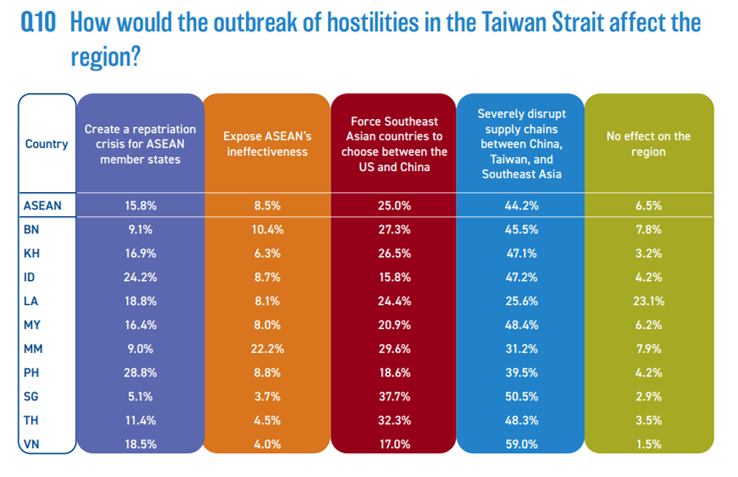
The second highest response to Question 10 is that the Southeast Asian countries feature that they would be “forced to choose between the US and China,” with 25 percent. However, at the country level, Singaporean and Thai respondents are ranked the highest with 37.7 and 32.5 percent, respectively. The reason why is due to both countries balancing between China and the United States regarding economics, military, and security relations. A Taiwan conflict creating “a repatriation crisis for ASEAN member states” concerns 15.8 percent of respondents. However, the Philippine and Indonesian respondents make up the largest percentage that voice this concern, with 28.8 and 24.2 percent, respectively. Both countries had the highest number of respondents because Taiwan hosts a significant number of migrant workers from Indonesia and the Philippines.
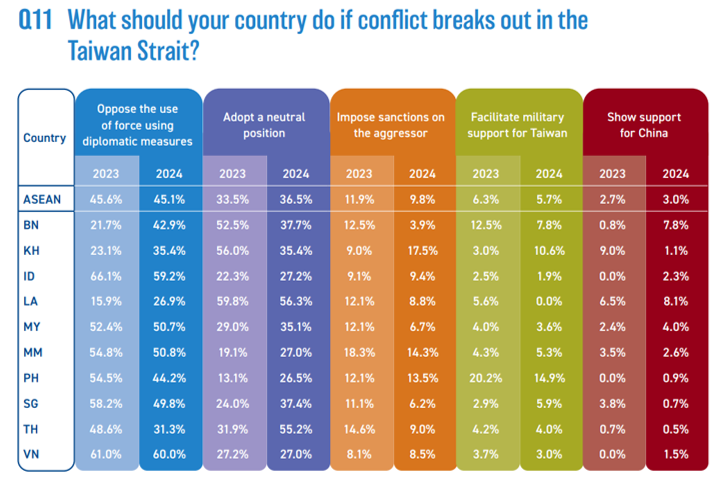
The other question concerned how respondents believed their countries should respond to a potential Taiwan conflict. Most of the survey’s respondents (45.1 percent) are opposed to the use of force and want their country to use diplomatic measures to end the conflict. Specifically, Vietnam and Indonesia have the highest respondents, with 60 and 59.2 percent, respectively. However, the percentage of respondents from both countries who voiced this view fell significantly from 2023’s survey, with Vietnam’s having the most significant decrease. The second highest respondents would prefer for their countries to “adopt a neutral position” in any conflict at 36.5 percent, a three percent increase from last year’s survey. At the country level, Laos and Thailand have the highest numbers of respondents who advocate for this position. However, Myanmar and Vietnam have the lowest number of respondents who say their countries should be neutral in the conflict.
Regarding the other three responses, respondents voice little support for imposing sanctions on the aggressor (9.8 percent), facilitating military support for Taiwan (5.7 percent), and showing explicit support for China (3.0 percent). The largest percentage of respondents who say they want their country to facilitate military support for Taiwan are from the Philippines (14.9 percent). The survey pointed out that the Philippines granted the United States access to four additional facilities under the Enhanced Defense Cooperation Agreement. However, the country also increased its defense and security relationship with the United States in other ways, such as by increasing military exercises. However, the second highest percentage of respondents who voiced support for providing military support to Taiwan were from Cambodia, with 10.6 percent. Cambodia’s 10.6 percent of respondents represents a 7.6 percent increase from 2023’s survey.
Chinese Vs. American Popularity
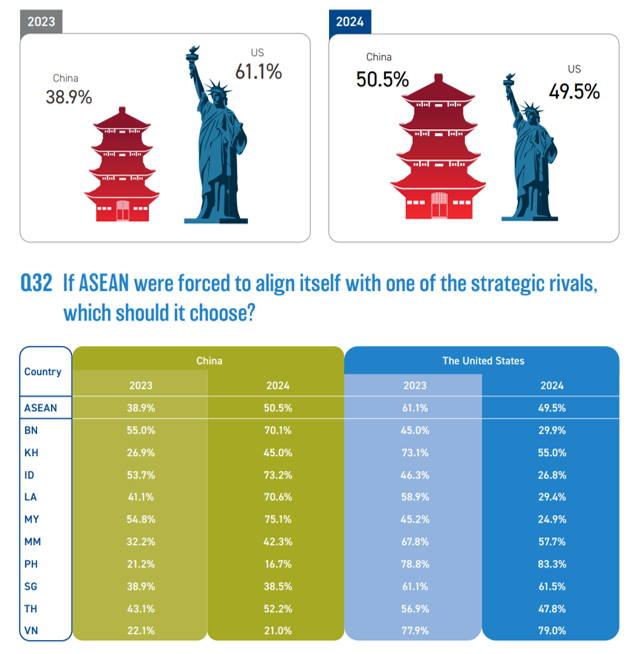
China’s popularity increased significantly among respondents in Southeast Asia, going from 38.9 percent in 2023’s survey to 50.5 percent in 2024. Among the countries that have the most respondents who would prefer to align with China, Malaysia, Indonesia, Laos, Brunei, and Thailand have the highest percentages, ranging from 75.1 percent (Malaysia) to 52.2 percent (Thailand). Furthermore, China saw a substantial increase of approximately 20 percent in respondents in Indonesia, Laos, and Malaysia voicing their view that their countries should align with China between 2023 and 2024. The survey pointed out that the increase is due to the three countries benefiting greatly from China’s Belt and Road Initiative (BRI) and increased trade and investment relations.
In contrast to China’s increase, the United States’ popularity faced a steep decrease (11.6 percent) from 2023 (61.1 percent) to 2024 (49.5 percent). While the United States still has a significant amount of support in the Philippines, Vietnam, Singapore, Myanmar, and Cambodia, the percentage decreased from 2023 to 2024. However, both the Philippines and Vietnam saw an increase in respondents voicing that their countries should align with the United States. The rise was especially significant in the Philippines, increasing from 78.8 percent to 83.3 percent between the two surveys. The survey’s authors point to the country’s increasing their alliance with the United States due to China’s increasingly aggressive actions in the South China Sea (SCS).
Analysis
The survey is significant because it likely reveals how significantly sentiment changed in the Southeast Asia region between 2023 and 2024. For example, the respondents viewed U.S.-China decoupling and intensifying economic tensions between major powers as an increasing major issue in the region. They understand that the Southeast Asia region sits at a strategically important region in terms of international investment and trade and that their economies depend on them to varying degrees.
The respondents also understand that their countries would likely be caught between China and the United States if economic tensions increase between both countries. Furthermore, the respondents understand that tensions would adversely affect their countries’ economies, especially if they were forced to choose between two sides. China could use various economic coercive measures if the countries decide to increase relations with the United States over China. Furthermore, China could also use BRI investment or projects to entice or pressure the countries from increasing their relationship or siding with the United States.
The respondents not wanting their countries to side with either China or the United States also extends to a potential Taiwan conflict. Furthermore, they also understand that any conflict between China and Taiwan would adversely affect not only their economies but the overall regional economy. For example, the respondents understand that the conflict will severely disrupt global supply chains, which would adversely affect various industries that depend on supply chains for input materials. They also understand that countries rely heavily on supply routes to import various agricultural items, such as grain and meat animals. This would significantly impact the countries’ ability to feed their populations. Malaysia, Singapore, and Vietnam had the highest number of respondents that voiced their concerns about disrupted supply chains because they are uniquely positioned to be most affected by them.
However, the respondents also voiced their apprehension that a potential Taiwan conflict would mean that their countries would be forced to choose between China and the United States. Singapore and Thailand would be the most likely to be affected because the respondents understand that both countries actively balance between more powerful countries. Furthermore, the respondents also understand that countries balance between outside countries as a means of survival from being totally subsumed by an outside power.
The other question about the Taiwan conflict also gives insight into how respondents want their countries to respond to a Taiwan conflict. Specifically, most respondents in the region are opposed to the use of force and want their country to use diplomatic measures to end the conflict. The rationale behind the response is that most respondents likely understand that they are quantitatively and, in some areas, qualitatively outmatched by China. Another rationale is that the respondents also understand that their countries would have higher chances of ending the conflict diplomatically rather than militarily.
This is especially true for Indonesia and Vietnam, the countries with the highest number of respondents. However, a large group of respondents want their countries to be neutral during any conflict between China and Taiwan. The reason why is due to the countries not wanting to be in a position where they would have to choose between China and the United States. The respondents also believe their countries could better weather the conflict and limit the negative effects the conflict would have on their countries by adopting a neutral position.
The most significant aspect of the survey is how China’s popularity saw a substantial increase among respondents in the region, while the United States saw a similar decrease. This popularity is most evident in the relatively high percentages of respondents in Brunei, Indonesia, Laos, Malaysia, and Thailand who said their countries should align with China over the United States. The reason why is that due to increased economic, investment, and trade relations between the countries and China, the respondents directly benefited the population. For example, Indonesia, Laos, and Malaysia saw a significant increase in respondents voicing their view that the countries should align with China.
The three countries received investment from the BRI as well as increased trade between the countries during 2023 and into 2024. However, the respondents also view China more positively than the United States due to various reasons. For example, Indonesia and Malaysia, which are Muslim majority countries, may view the United States more negatively due to its support for Israel during the ongoing Gaza conflict. However, countries still have a positive, albeit decreased, view of the United States in the region. This positive view is especially true for respondents from the Philippines and Vietnam for different reasons.
The respondents in the Philippines have a positive view of the United States due to its increased support for the country’s ongoing dispute with China in the SCS. The positive view also extends to the continued economic support the United States has provided to the Philippines, especially in the last year. Furthermore, the positive view also occurred as several prominent Philippine individuals voiced their opposition for the country to increase its relationship with the United States, especially in the SCS dispute. Vietnamese respondents also view the United States in a similar fashion since the country also has a dispute with China in the SCS. Furthermore, Vietnam also increased its relationship with the United States within the last year as a hedge against becoming too reliant on China for defense, investment, and trade.


